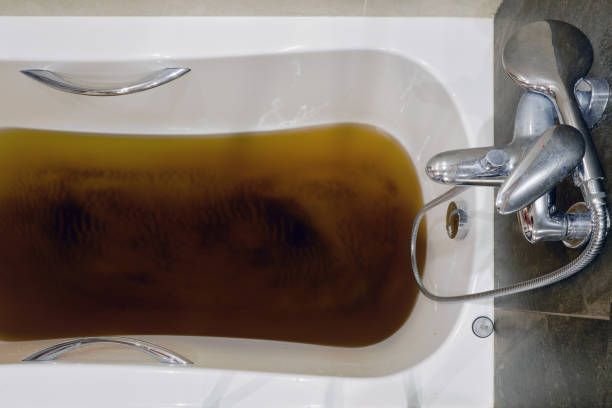Why Aren't Drain Cleanings Warrantied?

When I was a kid, Mama often fussed at me for clogging the toilet. Sorry, but I only knew one way to "get clean" before hopping off the throne. Even into adulthood, when visiting family and friends, a common question would be, "Where's your plunger?"
Since working at D&S Plumbing, I've learned that toilets aren't the only thing that will clog. Sometimes the entire home isn't flowing well, so you know there's a bigger problem.
Warranties
D&S Plumbing and Septic warranties all work for a year, and parts always have a manufacturer's warranty. Unfortunately, this doesn't apply to clearing clogs, many backups, nor drain cleaning. We have had unhappy customers who just can't understand why we charge every time we come out to clear the same clogged lines.
Common causes of clogged lines:
- Foreign objects poured down sink drains or flushed down toilets: Grease, hair and weaves, bars or pieces of soap, Q-tips, feminine products, toys, hair barrettes, jewelry, diapers, cloth or paper towels, etc.
- Roots in drain lines: Trees and shrubs love water and will find it where they can. Willows are notorious for this.
- Damaged or collapsed drain lines: Some very old pipes just wear out and collapse. Drain lines can also be damaged because they are buried too shallow, or because heavy vehicles run over them or are parked on them.
- Septic tank issues: The tank needs to be pumped/cleaned out regularly, sump pump/sewer pump isn't working (if you have one), field lines are too full or damaged (often by trees and shrubs).
Most of the time, the problems are caused by human error, as you can see from the first list. The only things that are supposed go into the drain lines are water, human waste, and toilet paper (in small quantities at a time, LOL). While some items might fall down the sink accidentally, too often, these items are poured down a sink or flushed intentionally. There are things that are beyond your control, too, as the rest of the list indicates.
Every time we send one of our
plumbers out to address backups, they go through a step-by-step process to clear the blockage, then check to ensure everything's flowing smoothly.
- Plunger: Usually the homeowner or tenant has already done this. Even if they have, our plumber will do it again. Sometimes, just waiting a bit allows things to dislodge themselves and move along. (Especially if you're not a self-professed "professional" like Ashley, complete with rain boots, rubber gloves, nose clip, and lots of splashing. Thank goodness we do' send her to work in our customers' homes!) If plunging doesn't work...
- Run the sewer machine: Sometimes called an auger or snake, this is a machine that has a long cable with either a spring/screw-looking thing on the end, or little "blades" (they're not sharp, so won't harm the pipes). The cable spins so that it tears up and catches whatever is in the drain, then it can all be pulled back out, clearing the lines. If this doesn't clear the blockage, the next step is to...
- Camera the lines: Similar to the sewer machine, this is a machine that has a camera on the end. As it goes down the drain lines, the plumber can not only see what's causing the blockage, but also locate where it is. Unfortunately, this has to be done in clear lines because the camera can't see through poop. The plumber will then show the customer what the problem is and discuss options to fix it. That sometimes, but not always, leads to...
- Dig up and replace damaged drain lines. Whether the camera has shown roots or collapsed/damaged drain lines, the only way to fix the issue is to cut them out and replace them.
At every step of this process, the customer is consulted because each step adds to the bill. We don't do any work without the customer's approval, and there have been times when the customer wasn't willing to pay for that work. There have also been times when the customer didn't want to cut down a favorite tree that was damaging the lines. And of course there have been times that the customer wanted to do the work themselves, once the cause was identified. We only do the work authorized by the customer.
So, if the customer doesn't approve the work required to fix the problem once and for all, and we have to come back out, or we remove grease/foreign objects and come back out and remove grease/foreign objects again, we have to charge for the work. In the long run, it's much more economical to do the repairs required to correct the cause of the problem.
Only You Can Prevent Clogged Drains
- Do not pour grease down the sink, nor flush anything other than human waste and tissue.
- As soon as the drains start slowing down, use the plunger (toilets and sinks) and/or do the vinegar-and-baking-soda trick (in sinks only).
- Regularly snake your tub, shower, and bathroom sink lines to remove hair. You can get a small hand-held snake for under $10 at any hardware store, or the hardware isle of the grocery store.
- Only use toilet paper, not paper towels. Although there are some wipes that say they're septic-safe, they're not (see my post "Poop is Not Ice".
- Keep our number handy and call it when you require professional help: 678-272-8241 .
If you're a homeowner, it just makes sense to be diligent to prevent plumbing issues and prolong your plumbing system. If you're a tenant, you might want to read your lease carefully. Most rental agreements include a clause that gives your landlord the right to charge you for repairs, especially if it can be proven that human error is the cause of repeat backups.
Long story short: your sinks, tubs, and toilets are not garbage cans.



